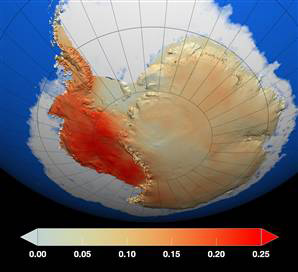
|  |  |  Editorials | Environmental | January 2009 Editorials | Environmental | January 2009  
Antarctica Study Challenges Warming Skeptics
 msnbc.com msnbc.com
go to original


| | This map by NASA shows temperature changes over the last 50 years on Antarctica. West Antarctica, separated from the east by a long mountain range, warmed faster. Temperature changes are measured in degrees Celsius. (NASA/GSFC) |  |
West side warming offsets cooling in parts of east side, researchers report

Challenging warming skeptics who note that parts of Antarctica have gotten colder, researchers on Wednesday reported that overall the continent has gotten warmer since the 1950s, and that even those colder spots would be warmer were it not for the ozone hole.

"Contrarians have sometime grabbed on to this idea that the entire continent of Antarctica is cooling, so how could we be talking about global warming," said study co-author Michael Mann, director of the Earth System Science Center at Penn State University. "Now we can say: No, it's not true ... It is not bucking the trend."

The study does not point to man-made climate change as the cause of the Antarctic warming — singling out a cause is a highly intricate scientific process — but a different and smaller study out late last year did make that connection.

"We can't pin it down, but it certainly is consistent with the influence of greenhouse gases" from fossil fuels, said NASA scientist Drew Shindell, another study co-author. Some of the effects also could be natural variability, he said.

The study showed that Antarctica — about one-and-a-half times bigger than the United States — remains a complicated weather picture, especially with only a handful of monitoring stations in its vast interior.

The researchers used satellite data and mathematical formulas to fill in missing information. That made outside scientists queasy about making large conclusions with such sparse information.

"This looks like a pretty good analysis, but I have to say I remain somewhat skeptical," Kevin Trenberth, climate analysis chief at the National Center for Atmospheric Research, said in an e-mail. "It is hard to make data where none exist."

Shindell said the study, published Thursday in the peer-reviewed journal Nature, was more comprehensive than past studies and jibed with computer models.

West vs. East

The research found that since 1957, the annual temperature for the entire continent of Antarctica has warmed by around 1 degree Fahrenheit.

The Antarctic Peninsula in West Antarctica has long been known to be warming, but the study noted that all of West Antarctica is about 20 degrees warmer than the east and has warmed nearly twice as fast, said study lead author Eric Steig of the University of Washington.

"Significant warming extends well beyond the Antarctic Peninsula to cover most of West Antarctica, an area of warming much larger than previously reported," the authors wrote.

Ten ice sheets on the Antarctic Peninsula have receded or collapsed since the 1990s. The Wilkins sheet is poised to break up, held in place by a sliver of ice 1,500-feet wide compared to 70 miles in the 1950s.

East Antarctica, which scientists had long thought to be cooling, is warming slightly when yearly averages are looked at over the past 50 years, said Steig.

However, autumn temperatures in East Antarctica are cooling over the long term, probably due to the ozone hole. And East Antarctica from the late 1970s through the 1990s, cooled slightly, Steig said.

"Efforts to repair the ozone layer eventually will begin taking effect and the hole could be eliminated by the middle of this century," Steig noted. "If that happens, all of Antarctica could begin warming on a par with the rest of the world."

Analysis overstated?

Some researchers skeptical about the magnitude of global warming overall said that the new study didn't match their measurements from satellites and that there appears to be no warming in Antarctica since 1980.

"It overstates what they have obtained from their analysis," said Roger Pielke Sr., a senior research scientist at the University of Colorado.

Steig said a different and independent study using ice cores drilled in West Antarctica found the same thing as his paper. And recent satellite data also confirms what this paper has found, Steig added.

The study has major ramifications for sea level rise, said Andrew Weaver at the University of Victoria in Canada. Most major sea level rise projections for the future counted on a cooling — not warming — Antarctica. This will make sea level rise much worse, Weaver said.

Antarctica's ice contains enough frozen water to raise world sea levels by 190 feet if it all melted, so even a tiny amount of melting could threaten Pacific island states or coastal cities from Beijing to London.

West Antarctica is particularly vulnerable because its ice sheet is grounded below sea level and surrounded by floating ice shelves. If that ice sheet completely melted, global sea level would rise by 16 to 20 feet.

Shindell predicted that West Antarctica "will eventually melt" over a long period of time "if warming like this continues." A 5.4 F rise could trigger a wide melt of West Antarctica, he said. |

 |
|  |



